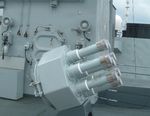Full "Sense-to-Effect" Torpedo Countermeasure Capability - ultra.group
←
→
Page content transcription
If your browser does not render page correctly, please read the page content below
Image: RMS Lusitania For over a hundred years submarines have lurked beneath the waves, providing a silent and current threat to surface shipping, both commercial and military. During World War I, the sinking of the RMS Lusitania by a torpedo fired from a German U-Boat showed the tactical advantages of having an underwater capability in maritime operations. World War II showed prolific use of torpedoes in the maritime battlespace, prompting the increasing need for anti-submarine warfare (ASW) to detect and counter such threats. Torpedoes provide an asymmetric “bang for buck”; they are low cost, proven and effective weapons. The threat of a torpedo attack remains pertinent, even in current times of low conflict, as demonstrated by the sinking of ROKS Cheonan in 2010, resulting in the loss of 46 crew. ASW is a game of “cat and mouse” covering knowledge of threats and countermeasures, each keeping up with the change in the pace of technology. Situational awareness of the underwater battlespace is the core need for a surface ship or fleet to assess the threat of attack. Sensors deployed from surface ships constantly listen to the environment to detect the presence of submarine or torpedo threats, with operators using gathered intelligence to classify them. To achieve a low false-alarm rate, it is necessary for systems to reliably extract the essential signals from the ocean noise to confidently determine threats at tactically significant ranges where countermeasures can be effectively actioned. Passive sonar detection is used to avoid polluting the water with excess noise that the threat can detect. The detecting array of sonar sensors is streamed on a long tow cable behind the ship to take advantage of clear, quiet waters.
In the scenario of a torpedo attack, there is limited time to detect, classify and action the
countermeasure. Operators must have trust in anti-torpedo solutions to consistently detect at
appropriate ranges with reliable alarms for incoming torpedoes.
A trusted solution that meets Navy needs should provide an integrated sense-to-effect capability
combining the sense signal with intelligence to automatically classify and provide the correct evasion
and countermeasure tactics (which could mix decoys and ship manoeuvres) in a time-critical situation.
Simplicity in use is essential to address the human factors aspects during the engagement and is key to
maximising platform survivability.
Images: ASW torpedo attack and countermeasures
Reaction plans should consider the threat weapon type and current operating mode; actions to be taken
for straight running, acoustic homing and wake homing torpedoes differ since the final stages of their
attack patterns are different. Depending on the threat classification, the countermeasures include
appropriate ship manoeuvring and acoustic devices deployed from the ship to decoy or confuse
the threat. This is often referred to as a soft-kill approach as it does not aim to damage the incoming
torpedo, just distance, distract and confuse it and so preventing it from reaching its intended target. As
there is finite time to detect and defeat threats, the time taken to counter the threat directly impacts
platform survival.
Image: Torpedo threat divertedAs torpedo countermeasures systems have improved, so has the threat to counter the countermeasure.
Future torpedoes are anticipated to be quieter (reducing passive detection range). They have more
complex algorithms in their homing mechanisms that recognise a decoy and will not be so easily
confused by the soft-kill countermeasures of today.
Images: Expendable acoustic devices and evasive manoeuvres
The next developments in torpedo defence systems must address the evolution in the threat and
keep the balance in the underwater battlespace. The introduction of active sonar is recognised as an
important step in achieving this.
Effective defence requires a layered approach involving multiple sensors, such as a combination of active
and passive, augmented with other available ships sensors’ data such as surface radar and
electro-optical / infra-red. Data fusion techniques and enhanced visualisation give operators high
confidence in classification and accurate localisation of these emerging threats with low rates of false
alarm early in the engagement to maximise available response time.
Image: Electro-optical capabilityAs advanced threat weapons erode soft-kill countermeasure advantage capabilities, complimentary hard- kill solutions that disable or destroy the torpedo are emerging. Active tracking and threat engagement prediction increase hard kill effectiveness, with range extent and location accuracy bringing the biggest flexibility for navies to determine their choice of hard-kill solution. Developments in artificial intelligence and autonomous maritime systems also bring new possibilities with additional layers of torpedo defence. Force Protection becomes a simple enhancement. The solution characteristics of detection and defence can be separated and remain integrated across a fleet, sharing overall situational awareness and using appropriate Force Level countermeasure plans to protect assets and keep people safe. Ultra is the world leader in providing fully integrated sense-to-effect torpedo defence solutions and for over 20 years has been the trusted system of choice globally for many navies. We continue to develop and improve our torpedo detection and defence systems to ensure the crew we protect can retain the upper hand in this game of cat and mouse.
You can also read



























































